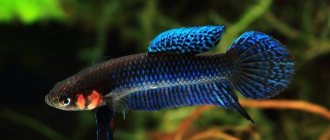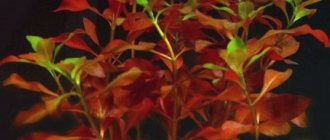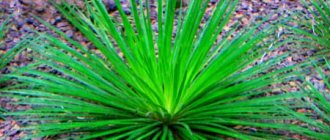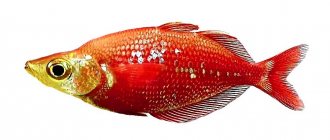Ludwigia is a prominent representative of ancient moisture-loving low-growing herbaceous plants that grow in marshy ponds and swamps containing clean water in most countries of the world with a warm climate.
This plant, which has been one of the most common inhabitants of various bodies of water in the tropical and subtropical climatic zones of the Earth for millions of years, has now significantly lost its species diversity.
The drainage of swamps, as well as other invasions of human civilization into the natural habitat of Ludwigia, contributed to the irreversible loss of many species of this ancient plant. Some species are endangered. Nowadays, there are no more than 75 species of Ludwigia, most of which were artificially bred by breeders. And this fact encourages many aquarists to decorate their aquariums with these undoubtedly colorful exotic plants.
Description
The aquarium plant Ludwigia is found in many home ponds. It not only decorates the aquarium, but also creates an optimal microclimate for the fish.
Ludwigia stands out even in the herbal book!
Ludwigia belongs to the fireweed or onagraceae family. The plant's habitat is quite extensive: Central and North America, Africa, Asia, Europe. Ludwigia prefers warm waters and can grow both on land and in water.
Distinctive features of Ludwigia:
- straight, curved stem up to 0.5 m long;
- branched shoots;
- numerous leaves.
The size, shape and color of the foliage depend on the species of the plant and the conditions of its maintenance. The color of the leaf blades varies from light green to purple.
With proper care, Ludwigia can bloom above water, which allows you to create unusual compositions from it in the aquarium. The main thing is to create suitable conditions for the plant.
How to plant
Ludwigia should be planted using cuttings.
It is recommended to plant in the autumn.
Ludwigia reproduces independently, subject to maintenance conditions.
Ludwigia is a magnificent plant that has long been actively used for the design and decoration of aquariums. A wide variety of species allows each aquarist to choose a variety according to his taste preferences.
Ludwigia is quite unpretentious in care, but for full growth and development this plant needs nutritious soil, moderate lighting and clean water. Some varieties are particularly demanding in terms of maintenance conditions, so they are recommended to be planted only by experienced users.
Planting and propagation
Sometimes there is a need to change the aquarium or change the decorative composition of a home pond. In this case, Ludwigia can be easily transplanted. You just need to carefully remove the plant from the soil and plant it in a new aquarium.
To quickly adapt, you need to pinch off the tip of the root while diving.
The decorative bush can also be propagated easily and quickly. This is done by cutting from an adult plant whose length exceeds 10 cm.
Cutting Ludwigia is an easy and quick process.
Side shoots with 4 or more nodes and 2-3 leaves are usually chosen as cuttings. The cut cuttings are planted directly in the ground or left to float in water until roots appear.
Ludwigia is planted in two ways:
- The cuttings are planted in the ground until the aquarium is filled with water. Thanks to this, the sprout is fixed much more firmly.
- The sprouts are immersed in a container filled with water, rooted in the substrate. This will allow you to choose the best place for the seedling.
To prevent the appearance of harmful microorganisms before planting, it is recommended to keep the cuttings in a saline solution for about 3-5 minutes (1 teaspoon of salt per 1 liter of water).
Ludwigia can develop not only in aquariums, but also in greenhouses and paludariums (an aquarium is an artificial swamp). After the plant takes root in a container of water and produces new shoots, the bush is placed in a pot with a nutritious soil mixture. To do this, mix sand with humus or peat with garden soil.
Fertilizers
Most ludwigias are picky about fertilizers. They need special mineral supplements. The plant needs to be fed from the moment of planting; for this purpose, the soil is mixed with small clay balls.
One of the important elements for the development of algae is iron. It allows you to preserve the intense color of the foliage. It is especially important to add fertilizing with this element to the aquarium: if you have chosen a plant with red leaves, they need iron the most. It is recommended to regularly feed Ludwigia with mineral fertilizers; such complexes contain everything you need.
Care and maintenance
Ludwigia has gained popularity among most aquarists due to its colorful appearance and relatively simple care.
In order for the plant to be truly beautiful and healthy, you need to create the appropriate conditions for it, presented in the table:
| Conditions of detention | Recommendations | |
| Water parameters | Temperature | 22-28оС |
| Rigidity | 5-6 dH | |
| Acidity | at least 7-8 pH, the higher the acidity, the richer the color of the leaves | |
For the beneficial growth of ludwigia, water changes should be carried out once a week, in an amount of 20-30% of the total volume. Lighting is required to be bright, but diffused for 10-12 hours a day; a more intense color and reddish tint is achieved by additional illumination with fluorescent lamps with a power of 0.4-0.5 W. Soil - a mixture of coarse sand or fine gravel with clay 3-4 cm thick. Top dressing - mineral fertilizers containing phosphorus, iron at the rate of 2 mg per 1 liter of water every 7-8 days, if necessary, top-up with carbon dioxide (20 mg per 1 l)
Ludwigia shoots grow very quickly, so the tops of the stems are periodically trimmed. This accelerates the growth of side shoots, giving the bush density and lushness.
It is recommended to plant the plant near the side walls of the aquarium. In the neighborhood it is advisable to place herbs that prefer the same conditions as ludwigia. But additional green spaces should have small foliage and not grow much. Otherwise, Ludwigia will experience a lack of light.
Ludwigia is compatible with many small fish that find refuge in its thickets. It is not recommended to place this plant in an aquarium with fish that dig in the ground. They can damage the roots of Ludwigia, which will lead to the death of the crop.
How to care
Ludwigia requires nutritious soil for full growth and development. Clay is considered the best soil for planting plants. Water hardness is allowed to be medium.
The most important thing for Ludwigia is to keep the aquarium clean.
The water must be changed regularly, otherwise a specific coating will form on the leaf blades of the plant. The optimal temperature is about +20-+25°C. Ludwigia requires additional lighting, especially in winter, but the plant also does not tolerate too much light.
The plant can do without fertilizers, but experienced aquarists still recommend using specialized fertilizers intended specifically for ludwigia in order to stimulate its growth and prevent various types of typical diseases.
Insufficient illumination and a deficiency of minerals in the soil can cause the death of ludwigia, especially in the initial stages of its development.
Kinds
Breeders have created many hybrid forms of Ludwigia, each of which has its own characteristics.
The most common types include the following:
Creeping or repens (Repens)
Oval shiny leaves of a dark green color, stem length about 30-40 cm.
floating
An elongated stem about 100 cm long with rounded leaf plates attached in pairs. It prefers to live on the surface of a reservoir, as it loses foliage under water.
Brevipes
A plant with double-colored leaf blades: the front side is reddish-green, the back is pinkish. With a lack of light, the foliage turns yellow, and when fertilized with carbon dioxide, the color of Ludwigia becomes more saturated.
Swamp or palustris (Palustris)
Branched stem, light olive foliage, tinged with reddish-purple at the base.
Tornado (sp.Tornado)
Bred in Vietnam. Characterized by curled leaves and thick stems.
Inclinata var.verticillata Cuba
When Ludwigia Cuba gets from its natural environment into an artificial reservoir, the leaf plates stretch, changing their oval shape to an elongated one, and the bright green shade turns into red-brown.
Peruvian or diamond (Peruensis)
With a powerful, long tree-like stem, dotted with large foliage of a fiery red hue on the back of the plates and rich green on top. Suitable for large aquariums with a volume of 150 liters or more.
Arc-shaped or arcuata
It is distinguished by long arched shoots, with pairs of bright green leaves. When the right conditions are created, the leaf blades acquire a reddish-brown color.
Super Red
One of the new species bred by Asian breeders. Distinctive features: bushes no more than 20 cm high, fleshy erect stem, scarlet leaves with a diameter of 3 cm, oblong in shape and wavy along the edge of the plate. The stem of the plant, like the leaves, is brownish-red in color, which gave the name to this variety - Super Red. At the top of the bush there is a rosette similar to a flower. The rich red hue remains vibrant even in low light.
Ruby (Repens "Rubin")
Originally from South America, it is considered one of the subspecies of Super Red due to the similarity in leaf color. In Ruby they are also covered in red, but much larger. Unlike Super Red Ludwigia, Rubin is very sensitive to light ; in low light the leaves turn pale.
Glandulose (glandular)
Thin, flexible stem that grows upward and needs pruning. The pinkish-red leaves are lanceolate in shape.
Mexico City (Senegalese)
An elongated stem with an opposite arrangement of rounded leaves with an unusual shade: a bright yellow vein runs through the center of the brick-scarlet plates.
Marilia
On a thin, long stem there are numerous yellow-green round leaves.
Ovalis
It is distinguished by an erect stem 15 cm high, oval, slightly elongated leaves with an unusual color: the rich green color turns dark red in intense light.
Green (Inclinata "Green")
Soft green oblong leaves are placed in pairs on a tall, erect stem. This type of ludwigia grows very quickly, adding 35-40 cm every week, and needs pruning.
Pylos
The length of the stems, spreading along the ground, reaches 20 cm, the greenish-brown leaves are connected into rosettes with a diameter of about 8 cm. Young foliage is colored brown-orange.
Using only Ludwigia of different subspecies you can achieve incredible beauty in your aquarium!
The choice of Ludwigia varieties is so extensive that any aquarist will be able to choose the right plant.
With the help of aquarium Ludwigia, you can create a unique design for your home pond. And the unpretentiousness of the plant allows even beginning aquarists to keep it.
Breeding
Ludwigia repens "Ruby" is very easily propagated by cuttings. To do this, the upper part of the main stem is cut off and planted in a new place or instead of an old plant. After pruning, the main bush produces a large number of side shoots, which makes it more attractive.
This is one of the most undemanding plants with red leaves and is also suitable for growing in wet greenhouses and paludariums. In addition, there it grows much faster, while the leaves become smaller and denser. Soil – turf soil, peat and sand. Air temperature is about 24-28 °C. The lighting is strong and diffuse.
Part 3. Most popular: Ludwigia
In Soviet times, there were only four pet stores in Moscow that sold aquarium products - on Arbat, on Kuznetsky Most, on Leninsky Prospekt and on Shchelkovskoye Highway near the Lilac Garden. Aquarium plants were extremely rare in them: they were usually not accepted for commission from the population, and Moszookombinat centrally grew only three species - pistia, Carolina cabomba and Ludwigia repens. I don’t know for what reason, but they were unable to produce commercially with other plants... Therefore, LUDWIGIA was present in the household of almost every Soviet aquarist with varying degrees of success.
Currently, a dozen species of Ludwigia grow in domestic aquariums. In addition to the veteran of the domestic aquarium hobby - Ludwigia repens and L. palustris and L. peruensis, which are very close to it, the holly-leaved L. arcuata, the brightly fiery L. glandulosa, similar to the alternanthera, and many others have mastered the aquariums of hobbyists.
Placement in an aquarium
Ludwigia red is ideal for creating contrasting compositions. The plant responds well to trimming; this feature allows it to be used in any part of the aquarium. If you plant it in the background, you will get a red and green background, reminiscent of a forest. With regular trimming, due to the growth of shoots, you can get free-standing beautiful plants, suitable for the central part and foreground of an aquarium panorama
Creeping Ludwigia does not tolerate shade; when placing it, it is necessary to avoid proximity to representatives of broad-leaved flora. If the plant does not have enough light, it will stop growing and then die completely.
In an aquarium, the plant performs not only a decorative function. Fry and weakened fish use it for shelter. It purifies water by feeding on organic matter in the water. Enriches the environment with oxygen. Fish hide in it to spawn. In addition, it is food for some aquarium inhabitants. But fish that like to dig will be bad neighbors for this plant. They can simply pull out the ludwigia by the roots.











